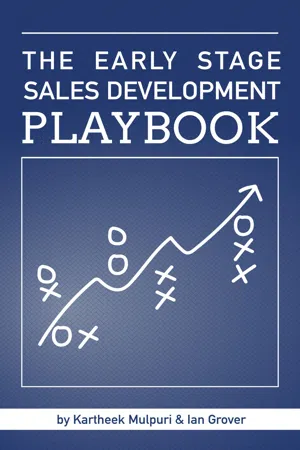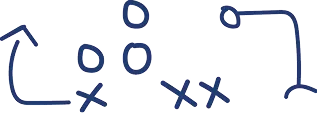
The Early Stage Sales Development Playbook
A Guide for the Newly Hired SDR
- English
- ePUB (mobile friendly)
- Available on iOS & Android
The Early Stage Sales Development Playbook
A Guide for the Newly Hired SDR
About this book
This straightforward, no-distractions guide to the sales development role at small- to mid-sized software firms will fast track your path to success in B2B sales. Get the inside scoop on everything from tools to mindset and jumpstart your sales career!
In The Early Stage Sales Development Playbook, Kartheek Mulpuri and Ian Grover pair extensive real-world sales experience with methodical research to bring you the best practices you need to succeed as a sales development representative at an early stage company.
How do I structure a successful outreach campaign?
How do I increase communication response rates?
How do I support my account executives, when given very little structure?
How do I keep a step ahead of the competition?
Find the answer these questions and more—if you're in or considering a career in technology sales, this book is for you. Up your game and edge out the competition with The Early Stage Sales Development Playbook!
Frequently asked questions
- Essential is ideal for learners and professionals who enjoy exploring a wide range of subjects. Access the Essential Library with 800,000+ trusted titles and best-sellers across business, personal growth, and the humanities. Includes unlimited reading time and Standard Read Aloud voice.
- Complete: Perfect for advanced learners and researchers needing full, unrestricted access. Unlock 1.4M+ books across hundreds of subjects, including academic and specialized titles. The Complete Plan also includes advanced features like Premium Read Aloud and Research Assistant.
Please note we cannot support devices running on iOS 13 and Android 7 or earlier. Learn more about using the app.
Information



Onboarding
Understand the Business
- What does the team look like today as a whole?
- Who are the leaders of the organization?
- What are the business’s short-term goals and objectives?
- What are the business’s long-term goals and objectives?
- What are recent milestones the company has achieved?
- Does the company have an engineer-driven or sales-driven culture?
- Who manages sales?
- Who does my manager report to?
- What is the org chart of the sales organization?
- Who are the point people in the organization for me to ask questions?
- How are decisions made in the sales organization?
- How should I interface with marketing?
- What have the results looked like thus far on lead generation?
- What have some of the challenges been on lead generation to date?
- How is reporting done?
- What are the key metrics the company tracks?
- What are the key metrics the sales team tracks?
- Does the team have collaborative meetings to discuss the status of leads and opportunities? If so, how often and when?
- What does the product do?
- What is the product intended to do?
- What is the long-term vision for the product?
- What features are in development?
- What are the shortfalls of the product today?
- Why wouldn’t a company buy the product?
- What value does the product deliver to the customer?
- How does the customer measure success?
- How does a customer calculate their Return on Investment (ROI)?
- How satisfied are customers with the product? (What is the Net Promoter Score?)
- What makes the product unique?
- Is this product a must-have or a luxury?
- How is the product positioned by the company today?
- Does the product require an implementation period or is it fully functional out of the box?
- If the product requires an implementation, what is the timeline?
- What are the target markets for the product? (Segment target markets by industry and/or buyer size)
- What is our Ideal Customer Profile (ICP)? (The ICP is the customer that would see the most value from your company’s product)
- How big is each target market and how are they prioritized?
- Is each target market growing (how quickly?) or contracting (how quickly?)
- What does competition look like for the solution?
- How does our product compare pricewise against competitors?
- If the product is more expensive, can the company justify the higher price due to better functionality?
Table of contents
- Contents
- Introduction
- Chapter 1: Overview
- Chapter 2: Preparation
- Chapter 3: Outreach
- Chapter 4: Lead Acceptance
- Chapter 5: Measuring an SDR’s Effectiveness
- Chapter 6: A Day in the Life of an SDR
- Chapter 7: The Little Things Go A Long Way
- Chapter 8: Conclusion
- Acknowledgements
- About the Authors